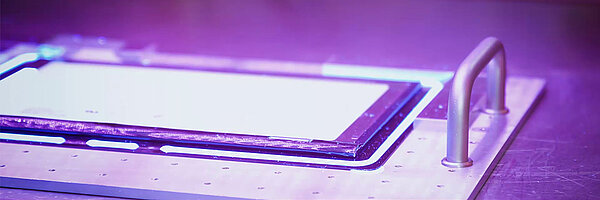Preactivation is a special variant of light curing. It allows using light to bond even opaque substrates.
If a company wants to manufacture several hundred thousand or even millions of units of a product per year, fully automated production processes and extremely short cycle times are essential. Light-curing or dual-curing adhesives are primarily used for this purpose.
The use of light-curing adhesives requires at least one component to be fully translucent such as glass, PC, or PMMA. Only then can the light energy lead to a complete chemical curing reaction.
Dual-curing adhesives are used when shadowed areas are present. These are areas where no light hits the adhesive after joining. Shadowed areas occur when both components to be joined are only partially or not at all translucent. The adhesive cures by light as far as possible. Its final curing in the shadowed areas takes place in a second downstream process.
However, the basic principle of light curing can be made use of even if two opaque substrates are used and there is no sufficiently large fillet – this is the adhesive that is visible between two components – for fixing the components.
This is where preactivated adhesives come into play. The special feature of preactivation is that the adhesive is irradiated directly after dispensing and before joining the components. So, the adhesive is applied to the first component and then irradiated for a few seconds, which triggers its crosslinking.
The adhesive retains its initial wettability during a short period called ‘open time’, thus allowing the two components to be joined and adjusted after the preactivation. The open time is typically 20 seconds, but can also be set to shorter or longer durations in customer-specific modifications.
The adhesive then cures within a few minutes until initial strength, without further exposure to light. From this moment on, the assembly can be further processed without the joined substrates slipping. The adhesive reaches its final strength within 72 hours without the need for further process steps. Additional heat can accelerate the curing process.
Since pictures may speak louder than words, watch this video where we explain the process of preactivation, and compare it with the standard light curing process:
Preactivated adhesives are used, for example, for decorative elements in car cockpits. They are available in a wide range of Young's moduli: as particularly flexible products based on modified urethane polymers (DELO PHOTOBOND LA) and as harder epoxy resins from the DELO KATIOBOND product line. This allows users to choose the right product for their mechanical, chemical, and thermal requirements.






